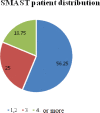Initial researches on neuro-functional status and evolution in chronic ethanol consumers with recent traumatic spinal cord injury
- PMID: 31406510
- PMCID: PMC6685305
- DOI: 10.25122/jml-2019-0026
Initial researches on neuro-functional status and evolution in chronic ethanol consumers with recent traumatic spinal cord injury
Abstract
We found differences related to the neuro-functional deficiency and clinical progress, among non-consumers and chronic consumers of ethanol, with recent traumatic spinal cord injury (SCI). We present a synthesis of related data on lesion mechanisms in post-traumatic myelogenous disorders, namely some of the alcohols and their actions on the nervous system, with details on the influences exerted, in such afflictions, by the chronic consumption of ethanol. The subject is not frequently approached - according to a literature review with systematic elements, which we have done before - thus constituting a niche that deserves to be further explored. The applicative component of the article highlights statistical data resulted from a retrospective study regarding the specialized casuistry from the Neuromuscular Recovery Clinic of the "Bagdasar Arseni" Emergency Clinical Hospital, following the comparative analysis of two groups of patients with recent SCI: non-consumers - the control group (n=780) - and chronic ethanol consumers - the study group (n=225) - with the addition of a prospective pilot component. Data processing has been achieved with SPSS 24. The American Spinal Injury Association Impairment Scale (AIS) mean motor scores differ significantly (tests: Mann-Whitney and t) between the control and study group in favor of the second, both at admission (p<0.001) and at discharge (p<0.001). AIS mean sensitive scores differ between the two lots, and also in favor of the study, but statistically significant only at discharge (p=0.048); the difference at admission is not significant (p=0.51) - possibly because of alcoholic-nutritional polyneuropathy. These findings, with numerous related details, later presented in the text, are surprising, which requires further studies and attempts of understanding.
Keywords: chronic alcoholism; ethanol; literature review; polyethylene glycol; recent traumatic spinal cord injury.
Figures






Similar articles
-
Preliminary results of using ALAnerv® in subacute motor incomplete paraplegics.J Med Life. 2015 Jul-Sep;8(3):297-304. J Med Life. 2015. PMID: 26351530 Free PMC article. Clinical Trial.
-
Against the odds: what to expect in rehabilitation of chronic spinal cord injury with a neurologically controlled Hybrid Assistive Limb exoskeleton. A subgroup analysis of 55 patients according to age and lesion level.Neurosurg Focus. 2017 May;42(5):E15. doi: 10.3171/2017.2.FOCUS171. Neurosurg Focus. 2017. PMID: 28463613
-
Granulocyte-colony stimulating factor administration for neurological improvement in patients with postrehabilitation chronic incomplete traumatic spinal cord injuries: a double-blind randomized controlled clinical trial.J Neurosurg Spine. 2018 Jul;29(1):97-107. doi: 10.3171/2017.11.SPINE17769. Epub 2018 Apr 27. J Neurosurg Spine. 2018. PMID: 29701561 Clinical Trial.
-
Patterns of Sacral Sparing Components on Neurologic Recovery in Newly Injured Persons With Traumatic Spinal Cord Injury.Arch Phys Med Rehabil. 2016 Oct;97(10):1647-55. doi: 10.1016/j.apmr.2016.02.012. Epub 2016 Mar 10. Arch Phys Med Rehabil. 2016. PMID: 26971670
-
Defining age-related differences in outcome after traumatic spinal cord injury: analysis of a combined, multicenter dataset.Spine J. 2014 Jul 1;14(7):1192-8. doi: 10.1016/j.spinee.2013.08.005. Epub 2013 Nov 7. Spine J. 2014. PMID: 24210580
Cited by
-
Molecular Aspects of Hypoxic Stress Effects in Chronic Ethanol Exposure of Neuronal Cells.Curr Issues Mol Biol. 2023 Feb 16;45(2):1655-1680. doi: 10.3390/cimb45020107. Curr Issues Mol Biol. 2023. PMID: 36826052 Free PMC article.
References
-
- Onose G, Haras M, Anghelescu A, Mureşanu D, Giuglea C, Daia Chendreanu C. Integrative emphases on intimate, intrinsic propensity/pathological processes - causes of self recovery limits and also, subtle related targets for neuroprotection/pleiotropicity/multimodal actions, by accessible therapeutic approaches – in spinal cord injuries. J Med Life. 2010;3(3):262–74. - PMC - PubMed
-
- Stoica SI, Chipăruş CE, Lapădat MV, Onose G. Aspecte ale programului de recuperare la un pacient cu tetraplegie incompletă post traumatism vertebro-medular cervical pe fond de crize convulsive generalizate secundare. Romanian J Med. 2017;LXIV(3):1.
-
- Hill CE. A view from the ending: Axonal dieback and regeneration following SCI. Neurosci Lett. 2017;652:11–24. - PubMed
-
- Blight A. Mechanical factors in experimental spinal cord injury. J Am Paraplegia Soc. 1988;11(2):26–34. - PubMed
Appendix
Publication types
MeSH terms
Substances
LinkOut - more resources
Full Text Sources
Medical
